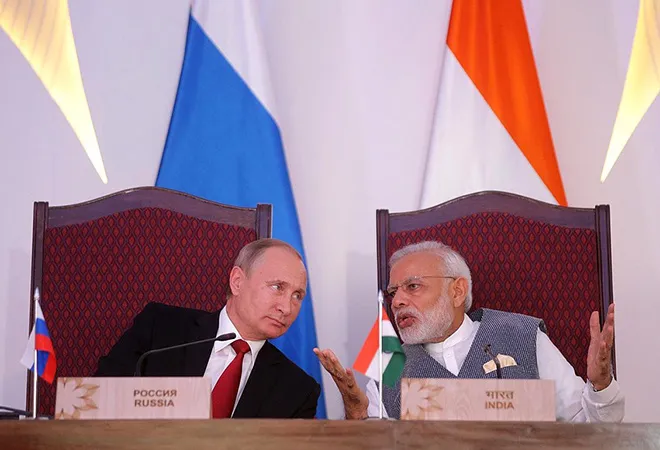
The Indo-Pacific has emerged as one of the contentious areas between India and Russia ever since India expressed its willingness to be part of this strategic construct and has taken several steps to shape its evolution. With India-Russia engagement picking up the pace with the first-ever 2+2 dialogue and subsequent annual summit, it is worthwhile to analyse the Russian element in India’s Indo-Pacific policy.
A general perception seems to have gained ground that due to India’s close relationship with the US, India’s Indo-Pacific policy is completely in sync with that of the US. However, that is far from the reality; there are many cracks in the way India and the US understand the concept of the Indo-Pacific. First, for the US, the geographic expanse of the Indo-Pacific terminates at the Western coast of India while India also treats West Asia and Eastern Africa as parts of its Indo-Pacific understanding. Second, India also gives substantial importance to the continental dimension—since it is both a land and maritime power; however, the US has not shown significant sensitivity to this fact, as is evident from American sanctions on Iran and the subsequent pressure on India to limit ties with Tehran. Third, the US gives more priority to the Pacific Ocean while India’s immediate priorities lie in the Indian Ocean. The US has thrown its weight behind Australia through the AUKUS alliance as it wants to ease some strategic pressure from itself by transferring nuclear submarine technology to Australia and letting Australia play a bigger role in the Pacific. India’s close military cooperation with Russia is one of the main reasons why India was reluctant and did not want to see substantial military activity through the Quadrilateral Security Dialogue. Equating Quad with Asian NATO missed the mark by a mile and this has been proven right as Quad would remain a non-military grouping while the military heavy lifting would be now done by the AUKUS.
A general perception seems to have gained ground that due to India’s close relationship with the US, India’s Indo-Pacific policy is completely in sync with that of the US.
The Indo-Pacific and the Quad are not directed against Russia and would not have any substantial impact on its security. The declassified Indo-Pacific strategy of the US in January 2021 mentions China, not Russia, as a security threat in the region, although it says that Moscow would remain a marginal player in the Indo-Pacific construct compared to the US, China, and India. Russia sees the Indo-Pacific and Quad initiatives as part of its friction with the US and has been very critical of them. Foreign Minister Sergey Lavrov has spoken against these initiatives many times. He had said in December 2020 that the West was pushing India to play a big role in its ‘anti-China’ policies like the Indo-Pacific and Quad; however, such statements were not expected from a strategic partner like Russia and were seen as Moscow’s failure to appreciate India’s security concerns vis-á-vis China. Later, Lavrov soothed Indian concerns by stating that Russia did not want any misunderstanding with India and the people of India on this issue. India has constantly made efforts to draw Russia in its formulation of Indo-Pacific. Foreign Minister S Jaishankar had emphasised during his Russia visit in July 2021 that India wanted a more active presence and participation of Russia in the Indo-Pacific, something which is contrary to the aim of declassified Indo-Pacific strategy of the US. Earlier, during his conversation at the Valdai Discussion Club in August 2019, Jaishankar had highlighted that India has an interest in the Pacific Ocean while Russia had an interest in the Indian Ocean. He also highlighted importance of new trade routes opening up in the Arctic while there was a lot of scope to cooperate with Russia’s Far East, Siberia, and the Arctic region. Jaishankar had even described Indo-Pacific as an extension of India’s Act East policy, and it may be mentioned that India had launched its Act Far East policy for increasing economic cooperation with Russia’s Far East, the Asian, and Pacific part of Russia. NITI Aayog and Ministry for Development of the Russian Far East and Arctic are working on a plan to develop the Arctic and Russia’s Far East between 2020 and 2025. The efforts to launch the Chennai-Vladivostok maritime route are also part of this policy. Prime Minister Modi had also highlighted in September 2021 that India and Russia would be partners in opening up of the Northern Sea Route for trade and commerce. India is also exploring the possibility of a trilateral cooperation with Japan and Russia in the Far East. These efforts from India are in line with Russia’s ‘Pivot to Asia’ that was launched in 2014, after Moscow’s relations with the US and Europe hit a nadir due to the Crimea crisis.
Equating Quad with Asian NATO missed the mark by a mile and this has been proven right as Quad would remain a non-military grouping while the military heavy lifting would be now done by the AUKUS.
Overlapping vision
A weak Russia is not in India’s favour and the latter wants to ensure that Russia is not left out of the Indo-Pacific construct. Russia’s active participation would make this region multi-polar which is what New Delhi is aiming for. Russia, although continues to oppose the American idea of Indo-Pacific but it has been supporting India’s efforts in this regard, as is evident from the Act Far East policy. Overall, it is worth mentioning that India’s vision of Indo-Pacific is very close to Russia’s concept of Greater Eurasian Partnership (GEP) that could from Lisbon to Vladivostok and was launched by Putin in 2015. Sergey Karaganov, a prominent Russian academic close to Putin had argued in 2016 that under the GEP, Russia would want to achieve an ideal geoeconomic and geopolitical position as a centre of Eurasia and would act as a friendly counterbalance to China so that it does not become too strong and become a potential hegemon that could scare away its neighbours. India’s Indo-Pacific vision also has the same aim and Russia active participation helps it to achieve its objectives. Vladivostok, the main city of Russia’s Far East evokes two contrasting emotions in India and China. In India, it is seen as a symbol of friendship with Russia as the former Soviet Union had dispatched a nuclear-armed flotilla, from its Pacific Fleet based in Vladivostok against the US navy’s attempts to threaten India during the India-Pakistan conflict in 1971. Soviet support was critical for India to deal with the US-China-Pakistan nexus during the 1971 war. This moment could also be treated as the beginning of India-Russia understanding on the Indo-Pacific which has a strategic history. In China, Vladivostok signifies humiliation and nationalism as it was part of China before 1860 and the Tsarist Russia had annexed it after China lost the Second Opium War against France and Britain. In July 2020, Russia embassy had posted a video on China’s micro-blogging site Weibo celebrating 160th anniversary of Vladivostok. However, the video was questioned by journalists and diplomats from China, saying Vladivostok was called ‘Haishenwai’ in China and reminded that generations would remember that it was once part of China. Some users even commented that their ancestral land would return to China in future. In contrast, Modi, during his 2019 address at the Fifth Eastern Economic Forum (EEF) had said that India was the first country to open a consulate in Vladivostok and the city was open to Indians even during Soviet times when there were restrictions on other foreigners.
The Indo-Pacific is not just about the US, and Russia’s worldview is likely to be incomplete without engaging with the Indo-Pacific as there’s the potential danger of making it dependent on China.
There are many versions of Indo-Pacific, depending upon the country in context and India’s version stands for open and inclusive Indo-Pacific in which Russia’s participation would make it multi-polar as well. Traditionally, the Russian elites have seen their country as European, but it also has Asian and Pacific dimensions. These elites based in Moscow, which has been Russia’s traditional seat of power, maybe contesting others who want Russia to be more proactive in the Pacific through its Vladivostok base. The Indo-Pacific is not just about the US, and Russia’s worldview is likely to be incomplete without engaging with the Indo-Pacific as there’s the potential danger of making it dependent on China. India and Russia have expressed their disagreements in public but the two countries have constantly made efforts to work on convergences through initiatives like Act Far East policy, Chennai-Vladivostok maritime route and energy cooperation in the Arctic. Through these initiatives, India seeks to invoke Russia’s Asian identity and help Russia’s ‘Pivot to Asia’ policy. India’s participation in Indo-Pacific and the Quad would ensure that these initiatives will not be used to target Russia. India and Russia are both, continental and maritime powers and India’s vision of Indo-Pacific is very close to Russia’s concept of Greater Eurasian Partnership (GEP), as both want to avoid hegemony of any power, be it the US or China.
The views expressed above belong to the author(s). ORF research and analyses now available on Telegram! Click here to access our curated content — blogs, longforms and interviews.




 PREV
PREV


